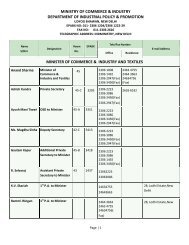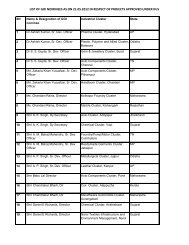fdi in india and its growth linkages - Department Of Industrial Policy ...
fdi in india and its growth linkages - Department Of Industrial Policy ...
fdi in india and its growth linkages - Department Of Industrial Policy ...
You also want an ePaper? Increase the reach of your titles
YUMPU automatically turns print PDFs into web optimized ePapers that Google loves.
FDI IN INDIA AND ITS GROWTH LINKAGES<br />
It can be observed that there is a decl<strong>in</strong>e <strong>in</strong> all three city classes when FDI manufactur<strong>in</strong>g plants are compared with<br />
domestic manufactur<strong>in</strong>g plants. In the case of Class-1 cities, the number drops from 27 hav<strong>in</strong>g domestic plants to 23<br />
hav<strong>in</strong>g FDI plants, though many of these would be common. The correspond<strong>in</strong>g decl<strong>in</strong>e is from 44 to 24 <strong>in</strong> the case of<br />
Class-2 cities. The decl<strong>in</strong>e is quite significant <strong>in</strong> the case of Class-3 cities; while 998 Class-3 cities have domestic<br />
manufactur<strong>in</strong>g plants, only 247 have FDI manufactur<strong>in</strong>g plants. However, many of these cities would be common<br />
between the two types of manufactur<strong>in</strong>g plants.<br />
6.2.3 Manufactur<strong>in</strong>g Firms’ Plants: Comparative Location across Country<br />
As noted earlier, manufactur<strong>in</strong>g plants are spread over 1,118 cities accord<strong>in</strong>g to the data <strong>in</strong> the Capital<strong>in</strong>e database.<br />
However, the data for 50 cities is provided only for FDI manufactur<strong>in</strong>g plants <strong>and</strong> not for domestic plants<br />
(Table 6.11); on the other h<strong>and</strong>, 824 cities have <strong>in</strong>formation only on domestic manufactur<strong>in</strong>g plants. The cities for<br />
which <strong>in</strong>formation is available either for only FDI manufactur<strong>in</strong>g firms or for only domestic manufactur<strong>in</strong>g firms<br />
are referred to as “unmatched cities” <strong>in</strong> this study. There are 244 cities for which plant-level <strong>in</strong>formation is<br />
provided for both FDI <strong>and</strong> domestic firms; these are termed “matched cities” <strong>in</strong> this study. However, this does not<br />
imply that alternative categories of manufactur<strong>in</strong>g plants, FDI <strong>and</strong> domestic, do not exist <strong>in</strong> unmatched cities<br />
though the <strong>in</strong>formation is not available <strong>in</strong> the Capital<strong>in</strong>e database. Thus, there may still be some FDI manufactur<strong>in</strong>g<br />
plants <strong>in</strong> the 824 unmatched cities on which <strong>in</strong>formation is available only for domestic manufactur<strong>in</strong>g firms<br />
<strong>and</strong> vice versa.<br />
There are 1,273 FDI plants located <strong>in</strong> 294 cities. These <strong>in</strong>clude 51 manufactur<strong>in</strong>g plants located <strong>in</strong> 50 unmatched cities<br />
<strong>and</strong> 1,222 plants located <strong>in</strong> 244 matched cities (Table 6.12). In the case of domestic manufactur<strong>in</strong>g plants, 2,330 plants<br />
are located <strong>in</strong> 824 unmatched cities <strong>and</strong> 8,335 <strong>in</strong> 244 matched cities. Thus, 80 per cent of all 11,938 manufactur<strong>in</strong>g<br />
plants are located <strong>in</strong> 244 matched cities (22 per cent of 1,118 cities).<br />
As observed, FDI manufactur<strong>in</strong>g plants are located <strong>in</strong> 294 cities though their co-existence with domestic manufactur<strong>in</strong>g<br />
plants is documented <strong>in</strong> 244 matched cities. All the 50 unmatched cities are Class-3 cities. In the case of matched cities,<br />
more than 80 per cent are Class-3 <strong>and</strong> less than 10 per cent are Class-1 (Table 6.13). Such a pattern of Class-3 cityconcentration<br />
is similar across the board <strong>in</strong> most of the major states. The share of Class-3 cities is 80 per cent or above<br />
<strong>in</strong> Andhra Pradesh, Gujarat, Haryana, Karnataka, Madhya Pradesh, Tamil Nadu <strong>and</strong> West Bengal with the share<br />
touch<strong>in</strong>g 93 per cent <strong>in</strong> Haryana <strong>and</strong> 87 per cent <strong>in</strong> Gujarat. However, the share of Class-3 cities among the matched<br />
cities is relatively low, at 61 per cent, <strong>in</strong> Maharashtra.<br />
The simultaneous existence of domestic <strong>and</strong> FDI manufactur<strong>in</strong>g plants <strong>in</strong> matched cities is important from the po<strong>in</strong>t of<br />
view of agglomeration economies. The two types of manufactur<strong>in</strong>g plants appear to have re<strong>in</strong>forced each other’s presence<br />
<strong>in</strong> cities across various states.<br />
The distribution of domestic manufactur<strong>in</strong>g plants across states <strong>in</strong>dicates that there are 8,335 plants across 244 matched<br />
cities with 3,754 plants (45 per cent) <strong>in</strong> Class-3 cities (Table 6.14). The share of domestic manufactur<strong>in</strong>g plants <strong>in</strong> Class-<br />
3 cities varies across the major <strong>in</strong>dustrial states, from as high as 57 to 58 per cent <strong>in</strong> Andhra Pradesh <strong>and</strong> Gujarat to as<br />
low as 19 per cent <strong>in</strong> Maharashtra <strong>and</strong> 24 per cent <strong>in</strong> Karnataka.<br />
The distribution of FDI manufactur<strong>in</strong>g plants across states <strong>in</strong>dicates that there are 1,222 plants across 244 matched<br />
cities with 640 plants (52 per cent) <strong>in</strong> Class-3 cities (Table 6.15). The share of FDI manufactur<strong>in</strong>g plants <strong>in</strong> Class-3<br />
cities varies across the major <strong>in</strong>dustrial states, from as high as about 83 per cent <strong>in</strong> Haryana, <strong>and</strong> 60 per cent <strong>in</strong> Andhra<br />
60












